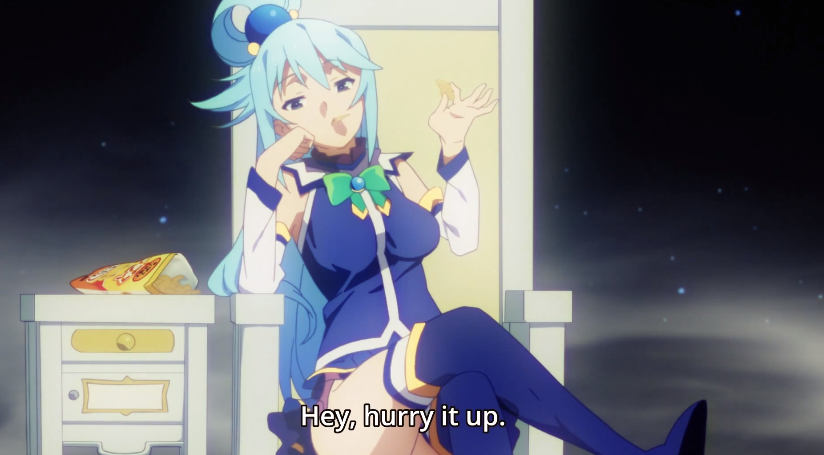Last week, I did a series of posts trying to come up with a new definition of what a light novel is. And among the definitions translated from Japanese, there was one from a blog post that seemed to catch people’s attention. The blogger tried to break down the definition of light novels into different categories, one of which was content, where they wrote…
2) Content (moe) faction
“It’s a light novel where a beautiful girl comes out and flirts with the main character.”
Which generated some amusement from Twitter users like Kuroka.
And, I admit that I found it kind of funny too.
Until I stopped and thought about it, and realized that maybe that Japanese blogger was on to something after all!
Now, I’m not saying that the blogger was right about it being “a light novel where a beautiful girl appears and flirts with the main character,” but I do think there’s a kernel of truth in there that’s worth considering. (And that little idea might just reveal a hidden aspect of light novels that people overlook.)
Because when I thought about it, I realized that the vast majority of light novels do have a single thing in common, whether they’re slice-of-life comedies like My Youth Romantic Comedy is Wrong As I Expected, or dark fantasy like Overlord, or war stories like 86, or even horror stories like Ghost Hunt.
At their core, they’re character-centred stories about relationships.
Often romantic relationships, but not always, no matter what the literary genre a light novel is presented as, it’s usually really about a relationship between two (or more) people.
Think about how most light novels begin?
The main character meets their soulmate.
How do they progress?
The two of them work together to understand each other and build a relationship together despite their circumstances.
How do they end?
The main character and the soulmate have created (or found) a world where they can live happily together.
This might sound like the plot of a romance story, but isn’t it also the plot at the core of most light novels in general? Yes, there’s some variation in how and when they meet that soulmate, but the soulmate is always there somewhere in the first few chapters (or first volume) and from that point on the story is anchored by that relationship.
They can fight wars, build empires, defeat demon kings, solve mysteries, conquer virtual worlds, or do any number of other epic things, but at the heart of the story it’s still just about two (or sometimes more) people experiencing life and growing through their mutual connection to each other. Everything else that happens in the story is just circumstances they have to deal with together to find their happiness with each other.
“But wait, Rob!” You cry!
“What about Overlord! You mentioned it up there, and Overlord definitely doesn’t have some sappy romantic crap at its cold magical core. Ainz doesn’t even have a heart, and Albedo might love him but they’re not ending up together in marriage or whatever.”

And, you would be right.
Which is why I refer to them as “relationship stories” not “romances”, and refer to the lead cutie the main character meets as their “soulmate” and not “love interest.” Because these stories aren’t always about love, but are about finding someone who completes you and accepts you as you are. They’re about characters finding a place and relationships they can call home, and building and protecting that “home” from outsiders who threaten it.
You can have a light novel that has no romance at all, but is still a relationship story between friends, siblings, classmates, co-workers, teacher and student, magician and familiar, or even a person and an inanimate object or setting. The key here is that by meeting that soulmate it unlocks a part of the character that needs to change, and the soulmate helps to make that change possible through their interactions with each other.
Sometimes it can even be a group, like in Overlord where Ainz comes to see the denizens of Nazarick as the family he never had while he was a single, lonely office worker. He has been thrust into the role of “father” to this collection of very human monsters, with a wife (Albedo), sister-in-law (Shalltear), brothers (Demiurge and Cocytus), children (Aura and Mare) and must learn to take care of them and build a “home” where they can be happy together. (By conquering the world and making it a safe place for them all to live instead of the corrupt place it is now.) However, most often, the story is one of a simple romance between the main character and one (or more) soulmate(s).

“Wait! Wait! Wait! Rob, but isn’t that most stories? Most stories have a romance in them, but that doesn’t make them about that relationship, that’s just a standard trope where the hero has a love interest they settle down with at the end!”
Yes and no.
Yes, even most non-romance stories have a romance thread running through them, and it’s usually an important part of the story because it represents the prize the character receives at the end when they finally find their personal truth and are ready to move on with their lives.
However, in light novels that relationship usually isn’t an extra, but the core of the story. Without that relationship, the story of the light novel often doesn’t happen. The meeting of the character and their soulmate is the inciting incident that sets off the whole story, and everything that follows that meeting until the end is linked with that meeting in some way. Even isekai stories where the character goes to another world don’t really start until the main character meets their soulmate on the other side – going to another world isn’t the inciting incident that sparks the story, the meeting with the soulmate once they get there is. Without that soulmate, the main character is just someone lost in the wilderness of a strange land. It’s the soulmate that helps gives them direction and focus once they get over to the other side.

Light novels are defined by the central relationship at their core.
Which makes sense when you think about who light novels are for and by.
Light novels are written with an older teen audience in mind, and read by people at a time in their life when their main life need is to find a partner and community which accepts them. They are still trying to learn how to navigate social relationships. And to them, not only are light novels escapist wish-fulfillment entertainment, but they let the readers experiment with social relationships in a safe and fun way while helping them understand who they are and what they want from their future partners. Not only that, they even teach the audience how to negotiate and interact with future partners (or at least how light novel writers think people interact, which is not always the same thing).
Next, at the same time, light novels originate in Japan, and Japan is a collective culture where everyone has their place and a role to play. In Japanese culture, happiness is finding a place where you can play your role to the best of your own personal fulfillment. Light novels act to re-assure the reader that there’s a soulmate and community out there for them somewhere. They just need to find it, in this world or the next, but they’re out there if the reader just keeps dreaming and hoping.
And last, light novels are aspirational by nature – encouraging their young readers that not only can they dream big, but they can make those dreams happen. If they just find the right spot for themselves and bring their talents out, they will be able to change the world. Even if their hobby is stamp collecting, kiteboarding, or photoshopping animal ears onto real people, there is a place for them out there where their skillset is valued, important, and can probably defeat a demon lord.
So again, everything comes back to relationships and a character-centered focus.
Not that light novel writers always have a choice.

Light novels are most often written by people who don’t have a whole lot of life experience, either because they’re young, or because they’ve led very simple lives. (Out of choice or circumstances – many light novel writers seem to be NEETS.) And this is why most light novels are built around characters because that’s really all the writer has to work with. They don’t know much about the real world, and they often don’t want to deal with it, so they would rather set their stories in a fantasy world where the world is just a backdrop for their original characters to interact and play out their imaginary stories.
This is one of the reasons why so many light novels are basically wish-fulfillment fantasy stories based on the dreams and desires of the writer. They’re bringing their dreams to life and sharing them with the world as a way to connect with others and create the communities they wish they had. And there’s always a soulmate character because it’s fulfilling some inner need on the part of the writer (and audience) who long for that connection with someone who truly understands them and completes them.
And who doesn’t want that?
This is one of the reasons why light novels have such universal appeal – because at their heart they’re based on universal needs and situations. You can even see it in their marketing, where the cover of a typical light novel looks like the cover of a dating sim. Often, they don’t even bother to show the main character because the main character isn’t the point, the cover features the fantasy soulmate(s) the book offers the reader a relationship with. Or, they show an image of the main character having fun with their friends (and soulmate) in an image of community.
Because in truth, there isn’t a lot of difference between light novels and visual novels, except that one of them lacks interactivity and the other has physical copies available. Both are stories about characters interacting with others and making choices which decide who they end up with and how it all turns out. Almost acting as teaching guides for the readers and a replacement for real relationships.
Anyhow, so if this is all true, and light novels are really about relationships, then how to use this information? What can we do with it?
Well first, and I know this is going to annoy some people, but if light novels really are relationship-centric by nature, then it offers a possible new definition of a light novel.
Let me give you an example.

Let’s say your novel idea is about a group of teens exploring a haunted house.
If that story’s main focus is learning the secret behind the haunted house and being picked off one by one as they try to escape alive, then it isn’t a light novel no matter what you put on the cover. That’s a type of survival horror story, not a relationship story, and while it might have relationships inside it, they’re not the focus of the story, so it doesn’t qualify as a light novel.
On the other hand, if the story’s main focus is the relationship between the two main characters, and surviving the house is just a means to bringing them together and closer as they learn to work as a team, then that would be a light novel story. Or, if you want to be a little creepier, the story is a relationship story between the main character and the evil house, and how the house brings out a side of the character they didn’t know they had. (Typically, in this story the character would end up becoming a new caretaker for the house in the end, fulfilling the “new home” requirement in a twisted way.) This too would be a light novel.
Without some aspect of “relationship with others” as its focus, a story simply wouldn’t qualify as a light novel because light novels are about relationships – full stop. It’s very similar to how the Japanese shonen manga formula is famously “Friendship – Effort – Victory.” and it requires those three elements to be a major part of the story. Although in this case, it would probably be something more along the lines of “Relationships – Aspirations – Fulfillment.” (And if those three sound familiar to you, go check out my book on manga and if you can find where I mention them there.)
This is also probably why when many people talk about light novels they talk about them having a “softer” tone – because they’re not about the hard edges and realities of life but about aspirational hopes and dreams. Even the darker ones, like Tanya the Evil or Overlord are at heart stories about family and community, and while they drift into darker and more nihilistic territory at times, they always come back to those central points.
Using this, we can also differentiate a light novel from other types of international fiction. Chinese webnovels are based around competition and outdoing each other, so the relationships in them are usually trophies they win by being the strongest, and are small parts of the story at most. Korean webnovels have much bigger elements of friendship and relationships in them, but in the end they’re still mostly about the main character kicking butt. American webfiction is still very individualistic and setting-based instead of character-based, usually being about how a character transforms a world through their awesomeness and relationships are prizes they win along the way. (Not unlike the Chinese stories.)
What will Original English Light Novels (OELNs) become?
That remains to be seen.
Have fun writing the future!
Rob


